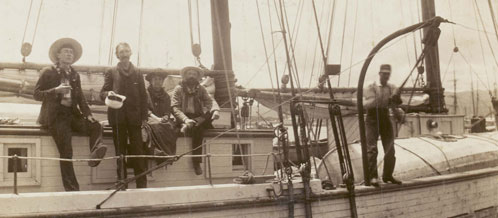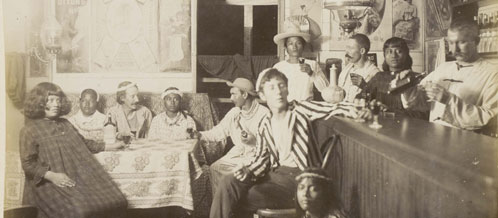
Note: Stevenson’s original spellings of places have been used in this section
The Equator was a small trading schooner owned by Wightman Brothers of San Francisco under Captain Dennis Reid. Stevenson made an agreement to go on their trip to the Gilbert Islands and then on to Samoa, paying a lump sum to stop longer at scheduled stops with an extra fee for any other stops. RLS’s plan was then to return to England for the early summer 1890.
The departure on 24 June 1889 is captured in the central photo in the photograph above: Lloyd sitting on the deckhouse with a wide-brimmed hat, RLS standing with cap in hand, Fanny and Mr Rick (agent for Wightman Bros. on Butataritari) sitting on the deckhouse, all wearing leis (floral garlands). Also accompanying them were Joe Strong as photographer and Ah Fu, their Chinese Cook, who had been with them since the Marquesas in the Casco cruise.
On the wharf were Belle and her son Austin: ‘The family all lined up on deck to be photographed as Austin and I climbed onto the wharf. They were still standing there waving to us as the schooner slowly moved away’ (Isobel Field [Belle Strong], This Life I’ve Loved [London: Charles Scribner’s Sons, 1937] pp. 241-42). The hull of the Equator is preserved in Port of Everett (Washington State, USA).
The Gilbert Islands
The Equator sailed S.W. for three weeks to Butaritari in the Gilbert Islands, a line of low coral atolls crossing the Equator and at that time still ruled by local chiefs. RLS’s movements (sailing down the island chain from north to south) were as follows:
•13 July, arrives at Butaritari
•13 July – 17 August on Butaritari
•17 – 20 August, on the island of Mariki
•21 – 25 August, on Apaiang atoll
•25 – 30 August, sailing to Apemama
•30 August – 25 October, on Apemama
•25 October – 7 December, sailing to Samoa via Butaritari
•7 December, arrives at Apia on Samoa (staying with H.J. Moors, Beach Road, Apia)
(i) Butaritari
The Equator arrived at Butaritari in 13 July 1889 and the Stevenson party stayed in the Wightman compound in the house of Robert Maka (a Hawaiian missionary) and his wife Mary. The Wightman bar, the “Sans Souci”, became RLS’s club in the evenings: “Here songs were sung, tales told, tricks performed, games played”
(In the South Seas, Tusitala Edition, vol. xx, [London: Heinemann, 1924], p. 231).
RLS describes the consequences of the lifting of the ban on alcohol just before their arrival (RLS is shocked at the sight of a vicious and bloody fight between two women).

Finally (and thanks in part to RLS’s activity) the ban is re-imposed. The other event that he describes is the visit of a party from the island of Little Makin and the five days of singing and dancing to greet them. The Stevenson party contributed to this with a magic lantern show.
During his stay, RLS was collecting material for his South Seas book, observing for example, the physical and cultural differences between the Gilberts in Micronesia and the Polynesian islands he had visited previously. RLS describes his stay on Butaritari in Part IV of In the South Seas (1896).
(ii) Marakiri
17 – 20 August. Not described in In the South Seas (1896).
(iii) Apaiang atoll
21 – 25 August. RLS spends the night on shore on 22 August.
(iv) Apemama (now Abemama)
Apemama was ruled by a picturesque tyrant king Tembinok and his portrait is a memorable part of In the South Seas (1896). The Equator arrived on 30 August but Tembinok gave his permission to land only two days later.
The Equator went off to other islands, leaving the Stevenson party behind. They lived in four light huts that Tembinok had ordered to be carried to a favourable spot (they called this “Equator Town”). It was here that RLS and Lloyd Osbourne started to write The Wrecker (finally published in 1892), inspired by a story of obscure maritime crimes that they’d heard in Honolulu.
The Equator returned on 19 October and they left on 25 October, going first north to Butaritari for a short stop and then south east for Samoa, where they arrived on 7 December. RLS describes his stay on Apemama in Part V of In the South Seas (1896).
By Richard Dury.
Image 1 courtesy of the Writers’ Museum (The Edinburgh Museums Service). Image 2 courtesy of Capital Collections
